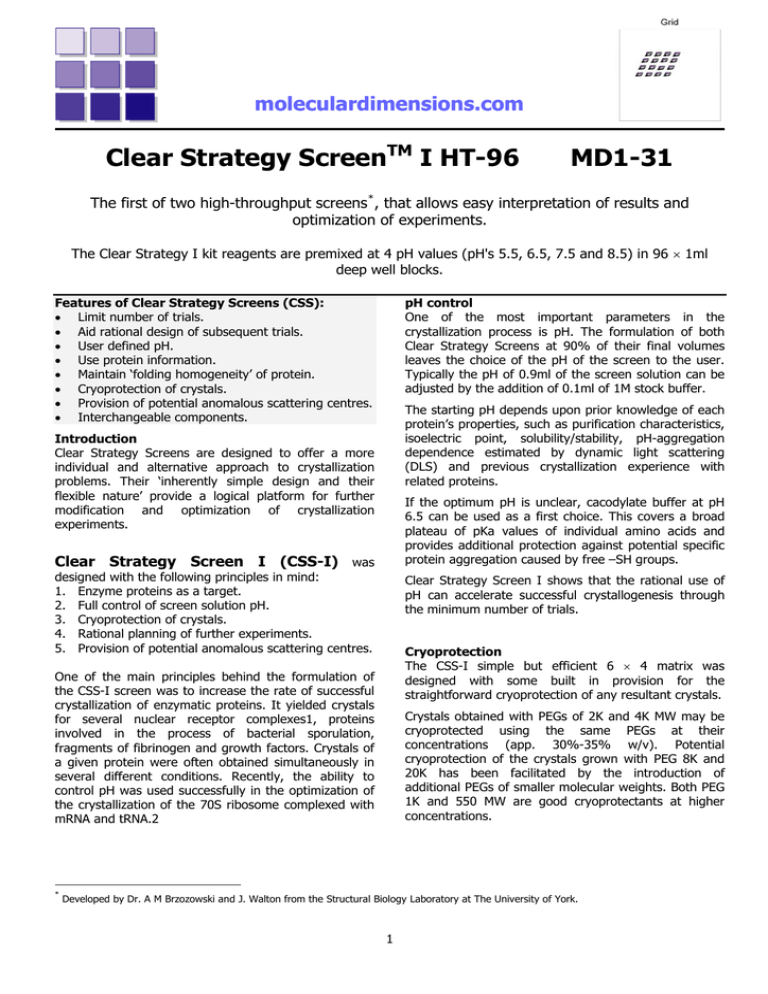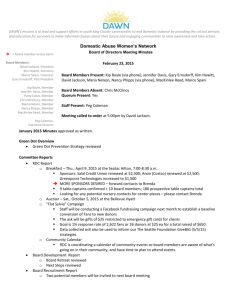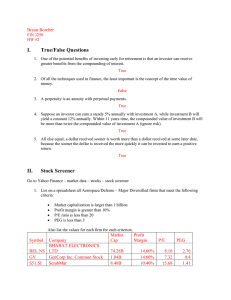Clear Strategy Screen I HT-96 MD1-31
advertisement

moleculardimensions.com Clear Strategy ScreenTM I HT-96 MD1-31 The first of two high-throughput screens * , that allows easy interpretation of results and optimization of experiments. The Clear Strategy I kit reagents are premixed at 4 pH values (pH's 5.5, 6.5, 7.5 and 8.5) in 96 × 1ml deep well blocks. Features of Clear Strategy Screens (CSS): • Limit number of trials. • Aid rational design of subsequent trials. • User defined pH. • Use protein information. • Maintain ‘folding homogeneity’ of protein. • Cryoprotection of crystals. • Provision of potential anomalous scattering centres. • Interchangeable components. pH control One of the most important parameters in the crystallization process is pH. The formulation of both Clear Strategy Screens at 90% of their final volumes leaves the choice of the pH of the screen to the user. Typically the pH of 0.9ml of the screen solution can be adjusted by the addition of 0.1ml of 1M stock buffer. The starting pH depends upon prior knowledge of each protein’s properties, such as purification characteristics, isoelectric point, solubility/stability, pH-aggregation dependence estimated by dynamic light scattering (DLS) and previous crystallization experience with related proteins. Introduction Clear Strategy Screens are designed to offer a more individual and alternative approach to crystallization problems. Their ‘inherently simple design and their flexible nature’ provide a logical platform for further modification and optimization of crystallization experiments. If the optimum pH is unclear, cacodylate buffer at pH 6.5 can be used as a first choice. This covers a broad plateau of pKa values of individual amino acids and provides additional protection against potential specific protein aggregation caused by free –SH groups. Clear Strategy Screen I (CSS-I) was designed with the following principles in mind: 1. Enzyme proteins as a target. 2. Full control of screen solution pH. 3. Cryoprotection of crystals. 4. Rational planning of further experiments. 5. Provision of potential anomalous scattering centres. Clear Strategy Screen I shows that the rational use of pH can accelerate successful crystallogenesis through the minimum number of trials. Cryoprotection The CSS-I simple but efficient 6 × 4 matrix was designed with some built in provision for the straightforward cryoprotection of any resultant crystals. One of the main principles behind the formulation of the CSS-I screen was to increase the rate of successful crystallization of enzymatic proteins. It yielded crystals for several nuclear receptor complexes1, proteins involved in the process of bacterial sporulation, fragments of fibrinogen and growth factors. Crystals of a given protein were often obtained simultaneously in several different conditions. Recently, the ability to control pH was used successfully in the optimization of the crystallization of the 70S ribosome complexed with mRNA and tRNA.2 * Crystals obtained with PEGs of 2K and 4K MW may be cryoprotected using the same PEGs at their concentrations (app. 30%-35% w/v). Potential cryoprotection of the crystals grown with PEG 8K and 20K has been facilitated by the introduction of additional PEGs of smaller molecular weights. Both PEG 1K and 550 MW are good cryoprotectants at higher concentrations. Developed by Dr. A M Brzozowski and J. Walton from the Structural Biology Laboratory at The University of York. 1 moleculardimensions.com These kits are produced by Molecular Dimensions Ltd under an exclusive license from University of York. Rational design of further experiments One of the main aims of the Clear Strategy I formulation is that the underlying principles should be very transparent to the user. A simple matrix of different PEGs Vs different salts combined with simultaneous control of pH enables both easy interpretation of results and planning of the next experiments. A new set of conditions can easily be achieved by an increase in the salt or PEG concentration, a shift towards one of the two mixed PEGs or even a change of the pH. References 1. Brzozowski and Walton (2001) J. Appl. Cryst. 34, 97 – 101. 2. Selmer et al (2006), Science 313, 1935 – 1942. 3. Dauter, Z, Dauter, M & Rajashankar, K. R. (2K), Acta Cryst. D56, 232 – 237. Anomalous scattering centres The coupling of new crystallization screens with modern methods to solve the crystallographic phase problem is of special importance for high throughput crystallography. One of the easiest ways to implement this3 is by soaking protein crystals in cryoprotectants containing Br- or I-. To increase the chance of the application of this important approach, one set of CSS-1 conditions includes potassium bromide. Several well diffracting crystals have been obtained from these conditions and we are currently evaluating whether initial phase estimates can be obtained through location of anomalous scatter sites. CSS-I is a simple, flexible and efficient screen that can be used in sitting drop, hanging drop and sandwich experiments. Formulation Notes To set up a screen: Clear Strategy Screens reagents are formulated using ultrapure water (>18.0 MΩ) and are sterile-filtered using 0.22 μm filters. No preservatives are added. Molecular Dimensions will be happy to discuss the precise formulation of individual reagents. Individual reagents and stock solutions for optimization are available from Molecular Dimensions. Enquiries regarding Clear Strategy Screen formulation, interpretation of results or optimization strategies are welcome. Please e-mail, fax or phone your query to Molecular Dimensions: enquiries@moleculardimensions.com Contact and product details can be found at: www.moleculardimensions.com 2 moleculardimensions.com Crystal Strategy Screen I HT-96 Well A1 A2 A3 A4 A5 A6 A7 A8 A9 A10 A11 A12 B1 B2 B3 B4 B5 B6 B7 B8 B9 B10 B11 B12 C1 C2 C3 C4 C5 C6 C7 C8 C9 C10 C11 C12 D1 D2 D3 D4 D5 D6 D7 D8 D9 D10 D11 D12 Salt 0.3 0.2 0.2 0.2 0.2 0.8 0.3 0.2 0.2 0.2 0.2 0.8 0.3 0.2 0.2 0.2 0.2 0.8 0.3 0.2 0.2 0.2 0.2 0.8 0.3 0.2 0.2 0.2 0.2 0.8 0.3 0.2 0.2 0.2 0.2 0.8 0.3 0.2 0.2 0.2 0.2 0.8 0.3 0.2 0.2 0.2 0.2 0.8 M M M M M M M M M M M M M M M M M M M M M M M M M M M M M M M M M M M M M M M M M M M M M M M M sodium acetate lithium sulfate magnesium chloride potassium bromide potassium thiocyanate sodium formate sodium acetate lithium sulfate magnesium chloride potassium bromide potassium thiocyanate sodium formate sodium acetate lithium sulfate magnesium chloride potassium bromide potassium thiocyanate sodium formate sodium acetate lithium sulfate magnesium chloride potassium bromide potassium thiocyanate sodium formate sodium acetate lithium sulfate magnesium chloride potassium bromide potassium thiocyanate sodium formate sodium acetate lithium sulfate magnesium chloride potassium bromide potassium thiocyanate sodium formate sodium acetate lithium sulfate magnesium chloride potassium bromide potassium thiocyanate sodium formate sodium acetate lithium sulfate magnesium chloride potassium bromide potassium thiocyanate sodium formate MD1-31 Buffer 0.1 M sodium acetate pH 5.5 0.1 M sodium acetate pH 5.5 0.1 M sodium acetate pH 5.5 0.1 M sodium acetate pH 5.5 0.1 M sodium acetate pH 5.5 0.1 M sodium acetate pH 5.5 0.1 M sodium acetate pH 5.5 0.1 M sodium acetate pH 5.5 0.1 M sodium acetate pH 5.5 0.1 M sodium acetate pH 5.5 0.1 M sodium acetate pH 5.5 0.1 M sodium acetate pH 5.5 0.1 M sodium acetate pH 5.5 0.1 M sodium acetate pH 5.5 0.1 M sodium acetate pH 5.5 0.1 M sodium acetate pH 5.5 0.1 M sodium acetate pH 5.5 0.1 M sodium acetate pH 5.5 0.1 M sodium acetate pH 5.5 0.1 M sodium acetate pH 5.5 0.1 M sodium acetate pH 5.5 0.1 M sodium acetate pH 5.5 0.1 M sodium acetate pH 5.5 0.1 M sodium acetate pH 5.5 0.1 M sodium cacodylate pH 6.5 0.1 M sodium cacodylate pH 6.5 0.1 M sodium cacodylate pH 6.5 0.1 M sodium cacodylate pH 6.5 0.1 M sodium cacodylate pH 6.5 0.1 M sodium cacodylate pH 6.5 0.1 M sodium cacodylate pH 6.5 0.1 M sodium cacodylate pH 6.5 0.1 M sodium cacodylate pH 6.5 0.1 M sodium cacodylate pH 6.5 0.1 M sodium cacodylate pH 6.5 0.1 M sodium cacodylate pH 6.5 0.1 M sodium cacodylate pH 6.5 0.1 M sodium cacodylate pH 6.5 0.1 M sodium cacodylate pH 6.5 0.1 M sodium cacodylate pH 6.5 0.1 M sodium cacodylate pH 6.5 0.1 M sodium cacodylate pH 6.5 0.1 M sodium cacodylate pH 6.5 0.1 M sodium cacodylate pH 6.5 0.1 M sodium cacodylate pH 6.5 0.1 M sodium cacodylate pH 6.5 0.1 M sodium cacodylate pH 6.5 0.1 M sodium cacodylate pH 6.5 3 Rows A – D Precipitant 25% w/v PEG 2K 25% w/v PEG 2K 25% w/v PEG 2K 25% w/v PEG 2K 25% w/v PEG 2K 25% w/v PEG 2K 15% w/v PEG 4K 15% w/v PEG 4K 15% w/v PEG 4K 15% w/v PEG 4K 15% w/v PEG 4K 15% w/v PEG 4K 10% w/v PEG 8K 10% w/v PEG 8K 10% w/v PEG 8K 10% w/v PEG 8K 10% w/v PEG 8K 10% w/v PEG 8K 8% w/v PEG 20K 8% w/v PEG 20K 8% w/v PEG 20K 8% w/v PEG 20K 8% w/v PEG 20K 8% w/v PEG 20K 25% w/v PEG 2K 25% w/v PEG 2K 25% w/v PEG 2K 25% w/v PEG 2K 25% w/v PEG 2K 25% w/v PEG 2K 15% w/v PEG 4K 15% w/v PEG 4K 15% w/v PEG 4K 15% w/v PEG 4K 15% w/v PEG 4K 15% w/v PEG 4K 10% w/v PEG 8K 10% w/v PEG 8K 10% w/v PEG 8K 10% w/v PEG 8K 10% w/v PEG 8K 10% w/v PEG 8K 8% w/v PEG 20K 8% w/v PEG 20K 8% w/v PEG 20K 8% w/v PEG 20K 8% w/v PEG 20K 8% w/v PEG 20K MME MME MME MME MME MME + 10% w/v PEG 1K + 10% w/v PEG 1K + 10% w/v PEG 1K + 10% w/v PEG 1K + 10% w/v PEG 1K + 10% w/v PEG 1K + 8% v/v PEG 550 MME + 8% v/v PEG 550 MME + 8% v/v PEG 550 MME + 8% v/v PEG 550 MME + 8% v/v PEG 550 MME + 8% v/v PEG 550 MME MME MME MME MME MME MME + + + + + + + + + + + + 10% w/v PEG 1K 10% w/v PEG 1K 10% w/v PEG 1K 10% w/v PEG 1K 10% w/v PEG 1K 10% w/v PEG 1K 8% v/v PEG 550 MME 8% v/v PEG 550 MME 8% v/v PEG 550 MME 8% v/v PEG 550 MME 8% v/v PEG 550 MME 8% v/v PEG 550 MME moleculardimensions.com Crystal Strategy Screen I HT-96 MD1-31 Rows E – H HT-96 Salt Buffer Precipitant Well E1 0.3 M sodium acetate 0.1 M Tris pH 7.5 25% w/v PEG 2K MME E2 0.2 M lithium sulfate 0.1 M Tris pH 7.5 25% w/v PEG 2K MME E3 0.2 M magnesium chloride 0.1 M Tris pH 7.5 25% w/v PEG 2K MME E4 0.2 M potassium bromide 0.1 M Tris pH 7.5 25% w/v PEG 2K MME E5 0.2 M potassium thiocyanate 0.1 M Tris pH 7.5 25% w/v PEG 2K MME E6 0.8 M sodium formate 0.1 M Tris pH 7.5 25% w/v PEG 2K MME E7 0.3 M sodium acetate 0.1 M Tris pH 7.5 15% w/v PEG 4K E8 0.2 M lithium sulfate 0.1 M Tris pH 7.5 15% w/v PEG 4K E9 0.2 M magnesium chloride 0.1 M Tris pH 7.5 15% w/v PEG 4K E10 0.2 M potassium bromide 0.1 M Tris pH 7.5 15% w/v PEG 4K E11 0.2 M potassium thiocyanate 0.1 M Tris pH 7.5 15% w/v PEG 4K E12 0.8 M sodium formate 0.1 M Tris pH 7.5 15% w/v PEG 4K F1 0.3 M sodium acetate 0.1 M Tris pH 7.5 10% w/v PEG 8K + 10% w/v PEG 1K F2 0.2 M lithium sulfate 0.1 M Tris pH 7.5 10% w/v PEG 8K + 10% w/v PEG 1K F3 0.2 M magnesium chloride 0.1 M Tris pH 7.5 10% w/v PEG 8K + 10% w/v PEG 1K F4 0.2 M potassium bromide 0.1 M Tris pH 7.5 10% w/v PEG 8K + 10% w/v PEG 1K F5 0.2 M potassium thiocyanate 0.1 M Tris pH 7.5 10% w/v PEG 8K + 10% w/v PEG 1K F6 0.8 M sodium formate 0.1 M Tris pH 7.5 10% w/v PEG 8K + 10% w/v PEG 1K F7 0.3 M sodium acetate 0.1 M Tris pH 7.5 8% w/v PEG 20K + 8% v/v PEG 550 MME F8 0.2 M lithium sulfate 0.1 M Tris pH 7.5 8% w/v PEG 20K + 8% v/v PEG 550 MME F9 0.2 M magnesium chloride 0.1 M Tris pH 7.5 8% w/v PEG 20K + 8% v/v PEG 550 MME F10 0.2 M potassium bromide 0.1 M Tris pH 7.5 8% w/v PEG 20K + 8% v/v PEG 550 MME F11 0.2 M potassium thiocyanate 0.1 M Tris pH 7.5 8% w/v PEG 20K + 8% v/v PEG 550 MME F12 0.8 M sodium formate 0.1 M Tris pH 7.5 8% w/v PEG 20K + 8% v/v PEG 550 MME G1 0.3 M sodium acetate 0.1 M Tris pH 8.5 25% w/v PEG 2K MME G2 0.2 M lithium sulfate 0.1 M Tris pH 8.5 25% w/v PEG 2K MME G3 0.2 M magnesium chloride 0.1 M Tris pH 8.5 25% w/v PEG 2K MME G4 0.2 M potassium bromide 0.1 M Tris pH 8.5 25% w/v PEG 2K MME G5 0.2 M potassium thiocyanate 0.1 M Tris pH 8.5 25% w/v PEG 2K MME G6 0.8 M sodium formate 0.1 M Tris pH 8.5 25% w/v PEG 2K MME G7 0.3 M sodium acetate 0.1 M Tris pH 8.5 15% w/v PEG 4K G8 0.2 M lithium sulfate 0.1 M Tris pH 8.5 15% w/v PEG 4K G9 0.2 M magnesium chloride 0.1 M Tris pH 8.5 15% w/v PEG 4K G10 0.2 M potassium bromide 0.1 M Tris pH 8.5 15% w/v PEG 4K G11 0.2 M potassium thiocyanate 0.1 M Tris pH 8.5 15% w/v PEG 4K G12 0.8 M sodium formate 0.1 M Tris pH 8.5 15% w/v PEG 4K H1 0.3 M sodium acetate 0.1 M Tris pH 8.5 10% w/v PEG 8K + 10% w/v PEG 1K H2 0.2 M lithium sulfate 0.1 M Tris pH 8.5 10% w/v PEG 8K + 10% w/v PEG 1K H3 0.2 M magnesium chloride 0.1 M Tris pH 8.5 10% w/v PEG 8K + 10% w/v PEG 1K H4 0.2 M potassium bromide 0.1 M Tris pH 8.5 10% w/v PEG 8K + 10% w/v PEG 1K H5 0.2 M potassium thiocyanate 0.1 M Tris pH 8.5 10% w/v PEG 8K + 10% w/v PEG 1K H6 0.8 M sodium formate 0.1 M Tris pH 8.5 10% w/v PEG 8K + 10% w/v PEG 1K H7 0.3 M sodium acetate 0.1 M Tris pH 8.5 8% w/v PEG 20K + 8% v/v PEG 550 MME H8 0.2 M lithium sulfate 0.1 M Tris pH 8.5 8% w/v PEG 20K + 8% v/v PEG 550 MME H9 0.2 M magnesium chloride 0.1 M Tris pH 8.5 8% w/v PEG 20K + 8% v/v PEG 550 MME H10 0.2 M potassium bromide 0.1 M Tris pH 8.5 8% w/v PEG 20K + 8% v/v PEG 550 MME H11 0.2 M potassium thiocyanate 0.1 M Tris pH 8.5 8% w/v PEG 20K + 8% v/v PEG 550 MME H12 0.8 M sodium formate 0.1 M Tris pH 8.5 8% w/v PEG 20K + 8% v/v PEG 550 MME Abbreviations: Tris; 2-Amino-2-(hydroxymethyl)propane-1,3-diol, PEG, polyethylene glycol (concentrations quoted as w/v %); MME, monomethyl ether; 1K, 2K, 4K, 8K and 20K correspond to the molecular weight, in thousands of Daltons, of PEG. Manufacturer’s safety data sheets are available upon request. 4





